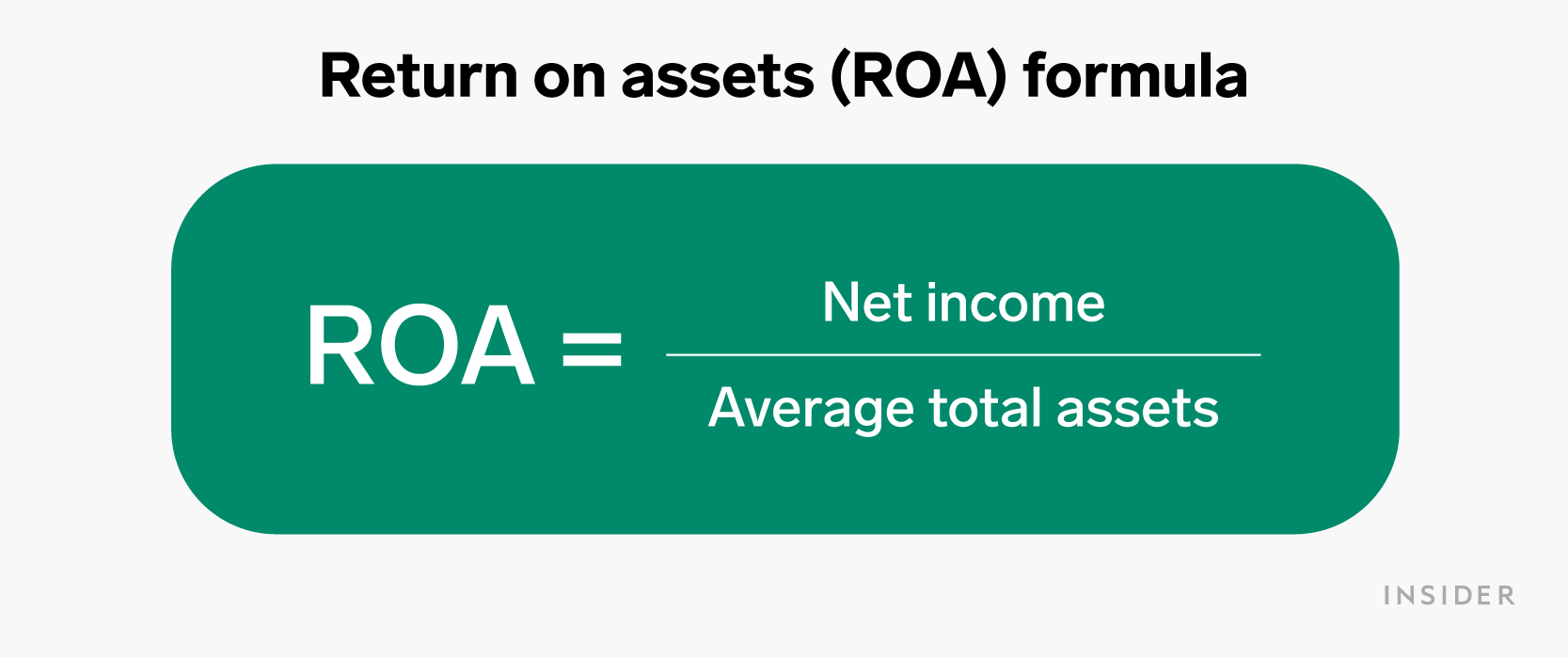
- Return on assets (ROA) is a key gauge of a company's profitability.
- The ROA ratio measures a company's net income relative to its total assets.
- A good ROA depends on the company and industry, but 5% or higher is considered good.
- Visit Insider's Investing Reference library for more stories.
Return on assets (ROA) is a ratio that measures a company's profitability relative to its total assets. It shows how well (or poorly) a company is using everything it owns – from machinery to vehicles and intellectual property – to earn money.
How ROA works
ROA is one way to measure an individual company's performance, by seeing if the ratio has been increasing or decreasing over time. A rising ROA indicates improving efficiency, while an ROA that is falling suggests a company might be spending too much on equipment and other assets relative to the profits it is earning from those investments.
Investors or managers can use ROA to assess the general health of the company to see how efficiently it's being run and how competitive it is. Investors often use ROA in deciding whether to put money into a company and evaluate its potential for returns relative to others in the same industry.
"ROA is used by investors to see how a company's profitability, relative to its assets, has changed over time and how it compares to its peers," says Michelle Katzen, managing director at HCR Wealth Advisors. "The ROA is one indicator that expresses a company's ability to generate money from its assets."
How do you calculate ROA?

The basic formula for ROA is to divide a company's net income by its average total assets, and then multiply the result by 100 to convert the final figure into a percentage.
- Net income: Revenue minus cost of goods sold minus expenses
- Average total assets: The total assets on a company's balance sheet at the end of the current year plus the total assets at the end of the previous year, divided by two
While this formula is the most popular, it's not the only one used to determine a company's ROA. Katzen says for non-financial companies, it can be helpful to add back interest expenses because of the inconsistency that can come from debt and equity capital being segregated.
"The values can differ if the formula is changed,'' says Adam Lynch, senior quantitative analyst at Schwab Equity Ratings. "Often these alternate versions vary the unit of time used in the calculation."
ROA Example
Here's an example of how to use data from Nike's balance sheets to figure its ROA for fiscal 2021
- First, find Nike's total assets at the end of fiscal 2021, which ended in May: $37.7 billion
- Next, find Nike's total assets at the end of fiscal 2020: $31.3 billion
- Add those together and divide by two to get average assets: $34.5 billion
- Divide its 2021 net income ($5.7 billion) by average assets ($34.5 billion) and then multiply the result by 100, which gives you 16.5%
So putting it all together, your formula looks like this when you plug in all the values:
ROA = (5.7/34.5)*100 = 0.1652 or 16.5%
What's considered a good ROA?
A "good" ROA depends on the company, the time frame of the calculation, and a few other factors. "It's all relative," says Lynch. "Better than your competition is what I'd aim for. Generally, you would compare competitive companies or industries."
As a benchmark, though, an ROA of 5% or better is generally considered to be acceptable.
"Generally speaking, an ROA of 5% or better is considered 'good,'" Katzen says. "But it is important to consider a company's ROA in the context of competitors in the same industry, the same sector and of similar size."
ROA vs. Return on Equity (ROE)
ROA is one of two primary measures managers and investors use to analyze a company's profitability level. The other is return on equity (ROE). Both provide a view of how effective a company is at using the money put into it to generate earnings.
The main difference between the two is that ROE tells investors how much income a company generates relative to each dollar of equity value. The formulas are similar. For ROE, the basic calculation is to divide net annual income by shareholders' equity, or the claim shareholders have on a company's assets, after its debts are paid.
"The main difference between ROA and ROE is the consideration of a company's debt," Katzen says. "When calculating ROE you subtract any liabilities the company has, utilizing net assets (or shareholders equity) instead of total assets."
The financial takeaway
ROA is an important measure of a company's return on investments. It shows how much profit is being generated relative to all of its assets. The higher the number, the greater the return.
For investors, ROA can be used in conjunction with other metrics (including ROE, which measures profit relative to equity value) to gain insight into a company's efficiency. It can be used to assess an individual company's performance over time or to evaluate it relative to similar companies in the same industry.
"The ROA is one indicator that expresses a company's ability to generate money from its assets," Katzen says. "Generally speaking, the higher the ROA, the more effective a company is at generating income for investors. The more income a company generates, the more likely the investment will appreciate."
